CTG Policy Impact on Indigenous Health: Judy's Case - UTS 92441
VerifiedAdded on 2023/06/08
|9
|2346
|488
Essay
AI Summary
This essay discusses the Closing The Gap (CTG) policy in Australia and its significance to the Torres Strait Islanders and Aboriginal people, analyzing Judy’s diabetes case and the social determinants of health. It explores the benefits of Judy being registered on CTG and discusses the roles of Aboriginal Medical Services (AMS) and Aboriginal Liaison Officers (ALO) in her care. The essay highlights the challenges and barriers affecting the CTG policy's implementation, such as insufficient funding and limited approval among Indigenous Australians, and concludes that the CTG policy has positively influenced social determinants of health, leading to improved standards of living and increased life expectancy. The essay also emphasizes the importance of addressing social determinants like income, employment, and education to improve health outcomes for Indigenous Australians.

Partial Title 1
ASSESSMENT 1: ESSAY
By Name
Course
Professor
University
City/State
Date
ASSESSMENT 1: ESSAY
By Name
Course
Professor
University
City/State
Date
Paraphrase This Document
Need a fresh take? Get an instant paraphrase of this document with our AI Paraphraser
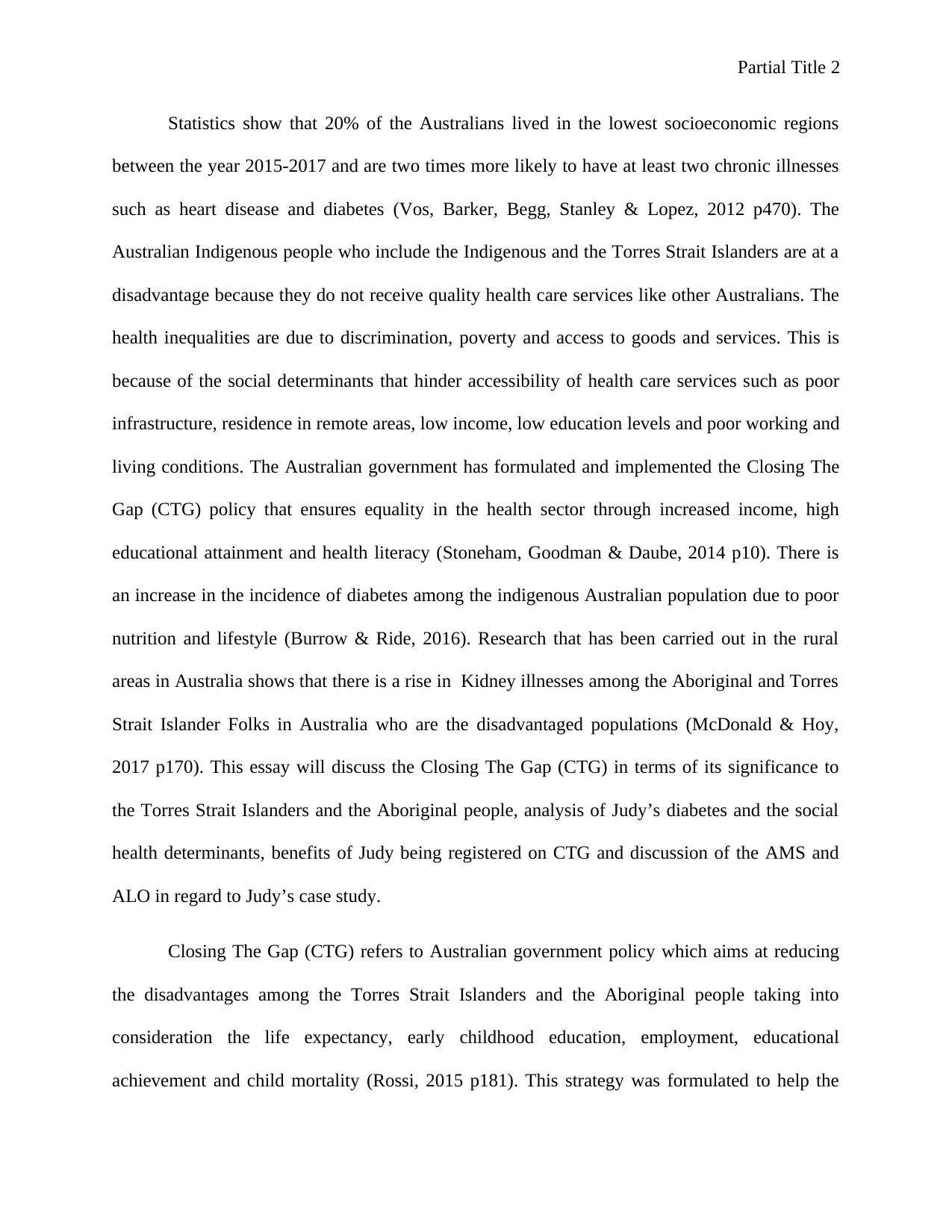
Partial Title 2
Statistics show that 20% of the Australians lived in the lowest socioeconomic regions
between the year 2015-2017 and are two times more likely to have at least two chronic illnesses
such as heart disease and diabetes (Vos, Barker, Begg, Stanley & Lopez, 2012 p470). The
Australian Indigenous people who include the Indigenous and the Torres Strait Islanders are at a
disadvantage because they do not receive quality health care services like other Australians. The
health inequalities are due to discrimination, poverty and access to goods and services. This is
because of the social determinants that hinder accessibility of health care services such as poor
infrastructure, residence in remote areas, low income, low education levels and poor working and
living conditions. The Australian government has formulated and implemented the Closing The
Gap (CTG) policy that ensures equality in the health sector through increased income, high
educational attainment and health literacy (Stoneham, Goodman & Daube, 2014 p10). There is
an increase in the incidence of diabetes among the indigenous Australian population due to poor
nutrition and lifestyle (Burrow & Ride, 2016). Research that has been carried out in the rural
areas in Australia shows that there is a rise in Kidney illnesses among the Aboriginal and Torres
Strait Islander Folks in Australia who are the disadvantaged populations (McDonald & Hoy,
2017 p170). This essay will discuss the Closing The Gap (CTG) in terms of its significance to
the Torres Strait Islanders and the Aboriginal people, analysis of Judy’s diabetes and the social
health determinants, benefits of Judy being registered on CTG and discussion of the AMS and
ALO in regard to Judy’s case study.
Closing The Gap (CTG) refers to Australian government policy which aims at reducing
the disadvantages among the Torres Strait Islanders and the Aboriginal people taking into
consideration the life expectancy, early childhood education, employment, educational
achievement and child mortality (Rossi, 2015 p181). This strategy was formulated to help the
Statistics show that 20% of the Australians lived in the lowest socioeconomic regions
between the year 2015-2017 and are two times more likely to have at least two chronic illnesses
such as heart disease and diabetes (Vos, Barker, Begg, Stanley & Lopez, 2012 p470). The
Australian Indigenous people who include the Indigenous and the Torres Strait Islanders are at a
disadvantage because they do not receive quality health care services like other Australians. The
health inequalities are due to discrimination, poverty and access to goods and services. This is
because of the social determinants that hinder accessibility of health care services such as poor
infrastructure, residence in remote areas, low income, low education levels and poor working and
living conditions. The Australian government has formulated and implemented the Closing The
Gap (CTG) policy that ensures equality in the health sector through increased income, high
educational attainment and health literacy (Stoneham, Goodman & Daube, 2014 p10). There is
an increase in the incidence of diabetes among the indigenous Australian population due to poor
nutrition and lifestyle (Burrow & Ride, 2016). Research that has been carried out in the rural
areas in Australia shows that there is a rise in Kidney illnesses among the Aboriginal and Torres
Strait Islander Folks in Australia who are the disadvantaged populations (McDonald & Hoy,
2017 p170). This essay will discuss the Closing The Gap (CTG) in terms of its significance to
the Torres Strait Islanders and the Aboriginal people, analysis of Judy’s diabetes and the social
health determinants, benefits of Judy being registered on CTG and discussion of the AMS and
ALO in regard to Judy’s case study.
Closing The Gap (CTG) refers to Australian government policy which aims at reducing
the disadvantages among the Torres Strait Islanders and the Aboriginal people taking into
consideration the life expectancy, early childhood education, employment, educational
achievement and child mortality (Rossi, 2015 p181). This strategy was formulated to help the
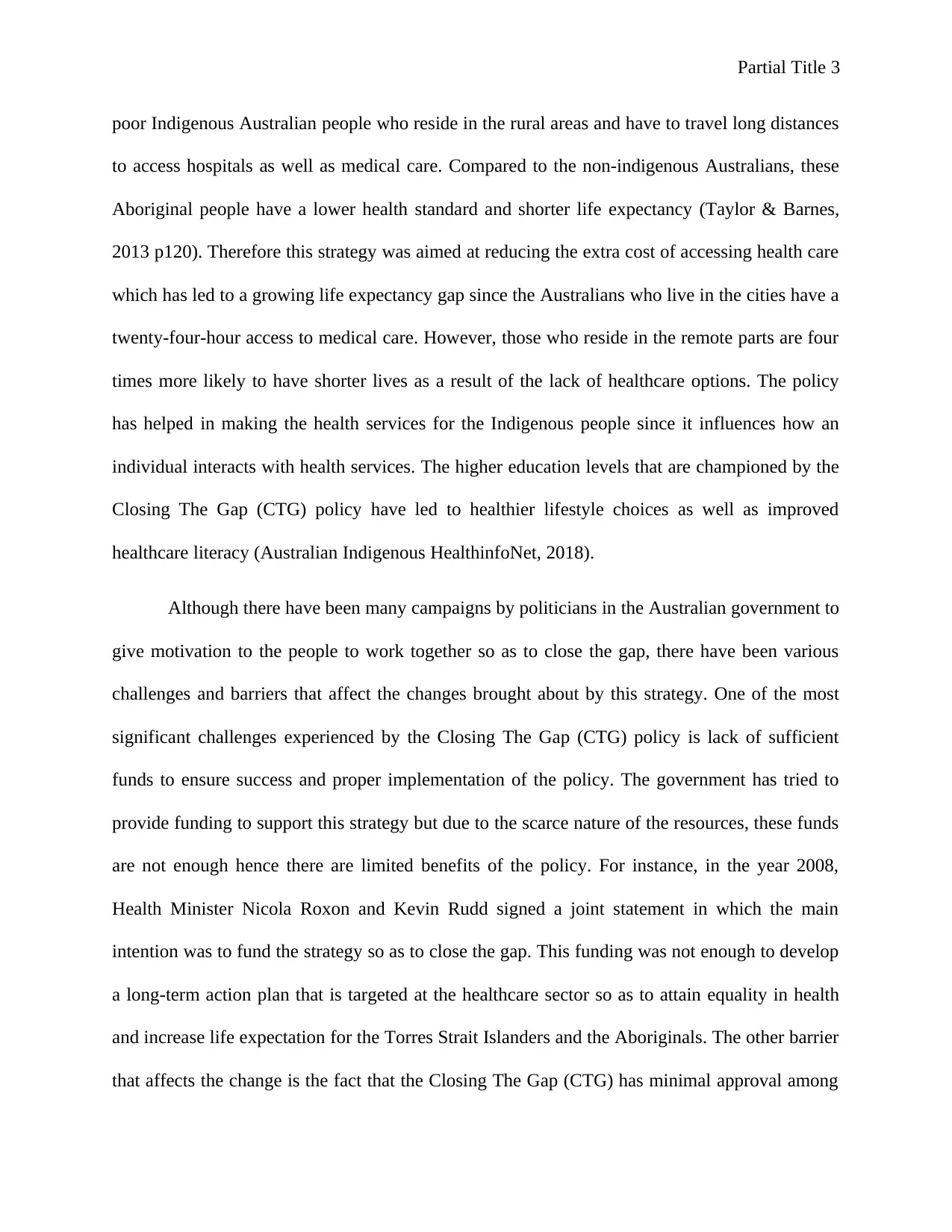
Partial Title 3
poor Indigenous Australian people who reside in the rural areas and have to travel long distances
to access hospitals as well as medical care. Compared to the non-indigenous Australians, these
Aboriginal people have a lower health standard and shorter life expectancy (Taylor & Barnes,
2013 p120). Therefore this strategy was aimed at reducing the extra cost of accessing health care
which has led to a growing life expectancy gap since the Australians who live in the cities have a
twenty-four-hour access to medical care. However, those who reside in the remote parts are four
times more likely to have shorter lives as a result of the lack of healthcare options. The policy
has helped in making the health services for the Indigenous people since it influences how an
individual interacts with health services. The higher education levels that are championed by the
Closing The Gap (CTG) policy have led to healthier lifestyle choices as well as improved
healthcare literacy (Australian Indigenous HealthinfoNet, 2018).
Although there have been many campaigns by politicians in the Australian government to
give motivation to the people to work together so as to close the gap, there have been various
challenges and barriers that affect the changes brought about by this strategy. One of the most
significant challenges experienced by the Closing The Gap (CTG) policy is lack of sufficient
funds to ensure success and proper implementation of the policy. The government has tried to
provide funding to support this strategy but due to the scarce nature of the resources, these funds
are not enough hence there are limited benefits of the policy. For instance, in the year 2008,
Health Minister Nicola Roxon and Kevin Rudd signed a joint statement in which the main
intention was to fund the strategy so as to close the gap. This funding was not enough to develop
a long-term action plan that is targeted at the healthcare sector so as to attain equality in health
and increase life expectation for the Torres Strait Islanders and the Aboriginals. The other barrier
that affects the change is the fact that the Closing The Gap (CTG) has minimal approval among
poor Indigenous Australian people who reside in the rural areas and have to travel long distances
to access hospitals as well as medical care. Compared to the non-indigenous Australians, these
Aboriginal people have a lower health standard and shorter life expectancy (Taylor & Barnes,
2013 p120). Therefore this strategy was aimed at reducing the extra cost of accessing health care
which has led to a growing life expectancy gap since the Australians who live in the cities have a
twenty-four-hour access to medical care. However, those who reside in the remote parts are four
times more likely to have shorter lives as a result of the lack of healthcare options. The policy
has helped in making the health services for the Indigenous people since it influences how an
individual interacts with health services. The higher education levels that are championed by the
Closing The Gap (CTG) policy have led to healthier lifestyle choices as well as improved
healthcare literacy (Australian Indigenous HealthinfoNet, 2018).
Although there have been many campaigns by politicians in the Australian government to
give motivation to the people to work together so as to close the gap, there have been various
challenges and barriers that affect the changes brought about by this strategy. One of the most
significant challenges experienced by the Closing The Gap (CTG) policy is lack of sufficient
funds to ensure success and proper implementation of the policy. The government has tried to
provide funding to support this strategy but due to the scarce nature of the resources, these funds
are not enough hence there are limited benefits of the policy. For instance, in the year 2008,
Health Minister Nicola Roxon and Kevin Rudd signed a joint statement in which the main
intention was to fund the strategy so as to close the gap. This funding was not enough to develop
a long-term action plan that is targeted at the healthcare sector so as to attain equality in health
and increase life expectation for the Torres Strait Islanders and the Aboriginals. The other barrier
that affects the change is the fact that the Closing The Gap (CTG) has minimal approval among
⊘ This is a preview!⊘
Do you want full access?
Subscribe today to unlock all pages.

Trusted by 1+ million students worldwide
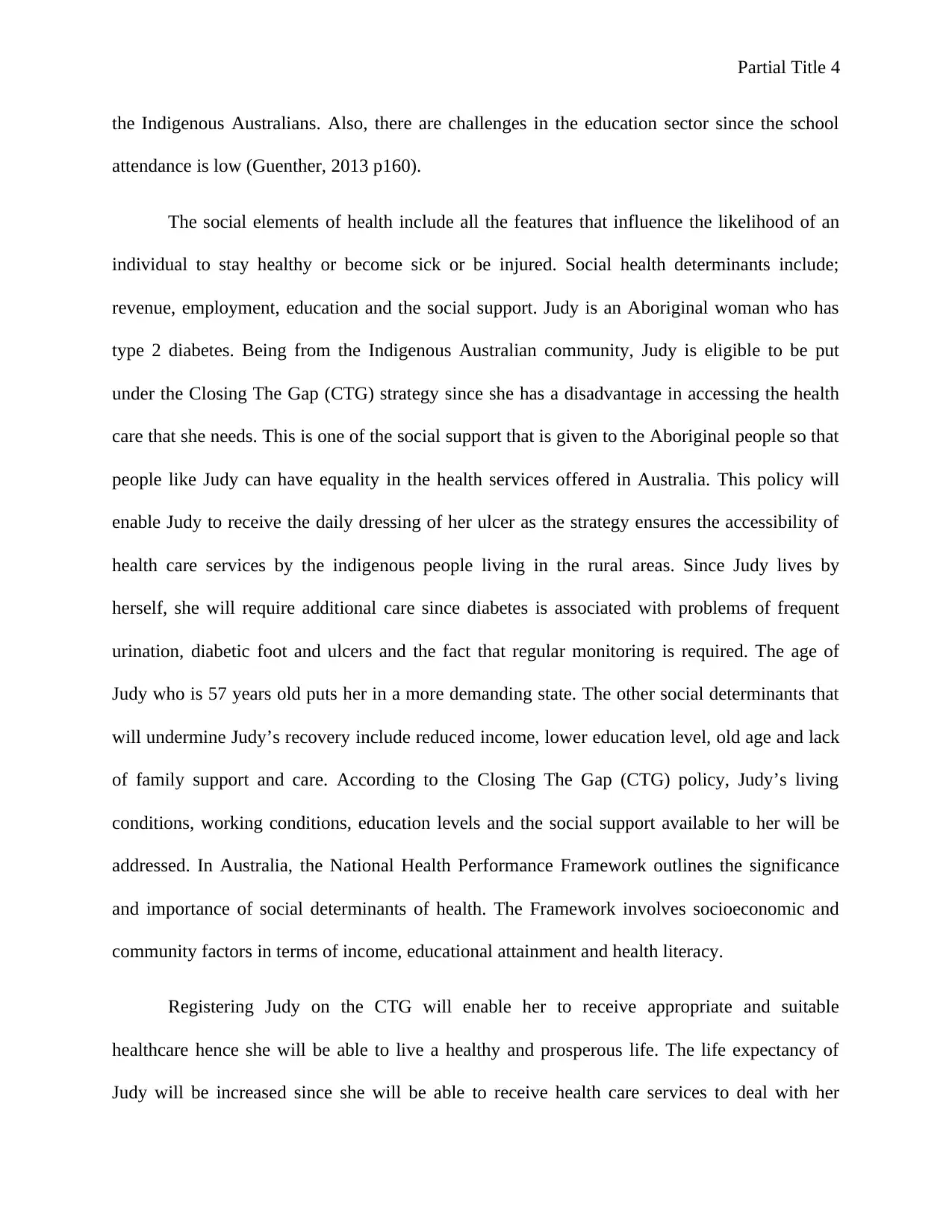
Partial Title 4
the Indigenous Australians. Also, there are challenges in the education sector since the school
attendance is low (Guenther, 2013 p160).
The social elements of health include all the features that influence the likelihood of an
individual to stay healthy or become sick or be injured. Social health determinants include;
revenue, employment, education and the social support. Judy is an Aboriginal woman who has
type 2 diabetes. Being from the Indigenous Australian community, Judy is eligible to be put
under the Closing The Gap (CTG) strategy since she has a disadvantage in accessing the health
care that she needs. This is one of the social support that is given to the Aboriginal people so that
people like Judy can have equality in the health services offered in Australia. This policy will
enable Judy to receive the daily dressing of her ulcer as the strategy ensures the accessibility of
health care services by the indigenous people living in the rural areas. Since Judy lives by
herself, she will require additional care since diabetes is associated with problems of frequent
urination, diabetic foot and ulcers and the fact that regular monitoring is required. The age of
Judy who is 57 years old puts her in a more demanding state. The other social determinants that
will undermine Judy’s recovery include reduced income, lower education level, old age and lack
of family support and care. According to the Closing The Gap (CTG) policy, Judy’s living
conditions, working conditions, education levels and the social support available to her will be
addressed. In Australia, the National Health Performance Framework outlines the significance
and importance of social determinants of health. The Framework involves socioeconomic and
community factors in terms of income, educational attainment and health literacy.
Registering Judy on the CTG will enable her to receive appropriate and suitable
healthcare hence she will be able to live a healthy and prosperous life. The life expectancy of
Judy will be increased since she will be able to receive health care services to deal with her
the Indigenous Australians. Also, there are challenges in the education sector since the school
attendance is low (Guenther, 2013 p160).
The social elements of health include all the features that influence the likelihood of an
individual to stay healthy or become sick or be injured. Social health determinants include;
revenue, employment, education and the social support. Judy is an Aboriginal woman who has
type 2 diabetes. Being from the Indigenous Australian community, Judy is eligible to be put
under the Closing The Gap (CTG) strategy since she has a disadvantage in accessing the health
care that she needs. This is one of the social support that is given to the Aboriginal people so that
people like Judy can have equality in the health services offered in Australia. This policy will
enable Judy to receive the daily dressing of her ulcer as the strategy ensures the accessibility of
health care services by the indigenous people living in the rural areas. Since Judy lives by
herself, she will require additional care since diabetes is associated with problems of frequent
urination, diabetic foot and ulcers and the fact that regular monitoring is required. The age of
Judy who is 57 years old puts her in a more demanding state. The other social determinants that
will undermine Judy’s recovery include reduced income, lower education level, old age and lack
of family support and care. According to the Closing The Gap (CTG) policy, Judy’s living
conditions, working conditions, education levels and the social support available to her will be
addressed. In Australia, the National Health Performance Framework outlines the significance
and importance of social determinants of health. The Framework involves socioeconomic and
community factors in terms of income, educational attainment and health literacy.
Registering Judy on the CTG will enable her to receive appropriate and suitable
healthcare hence she will be able to live a healthy and prosperous life. The life expectancy of
Judy will be increased since she will be able to receive health care services to deal with her
Paraphrase This Document
Need a fresh take? Get an instant paraphrase of this document with our AI Paraphraser
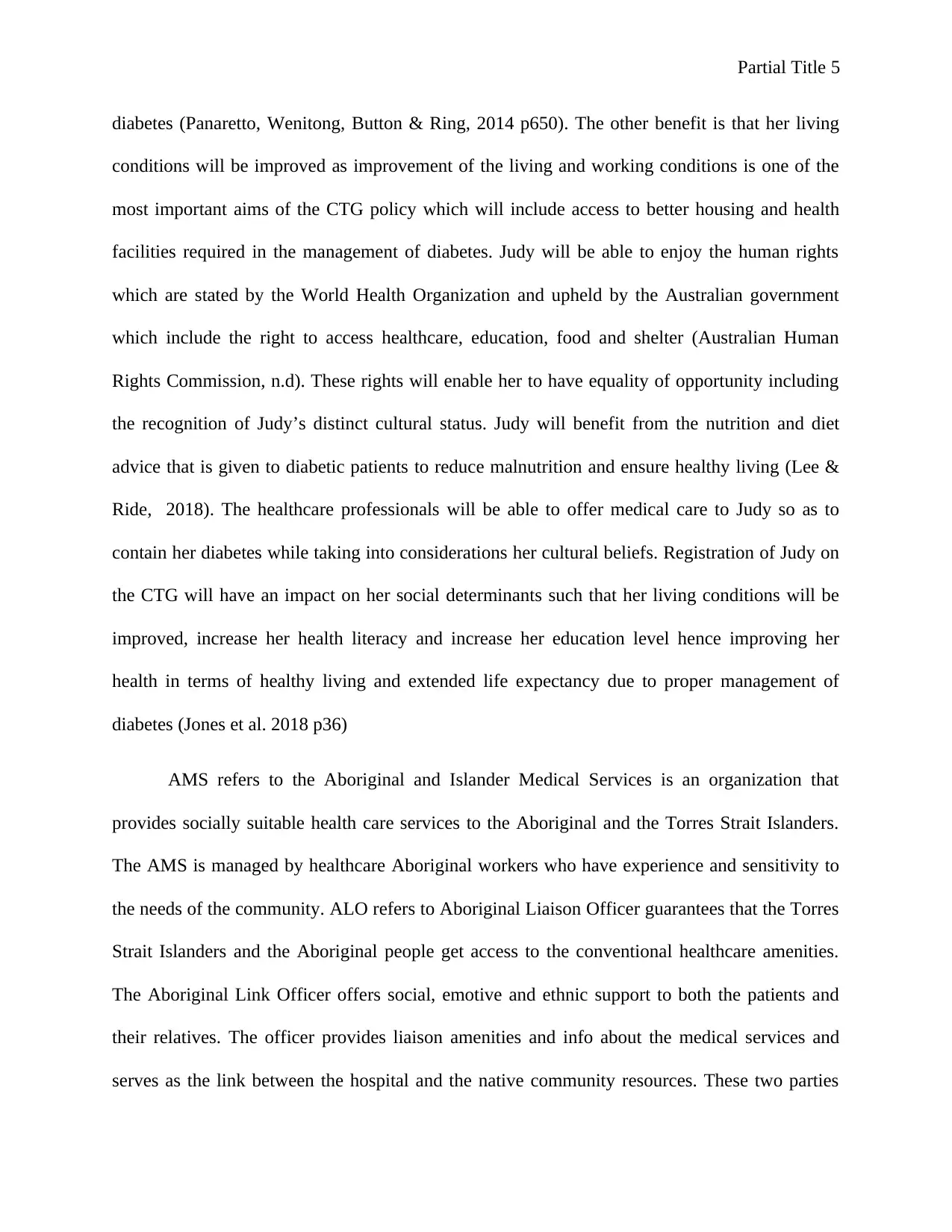
Partial Title 5
diabetes (Panaretto, Wenitong, Button & Ring, 2014 p650). The other benefit is that her living
conditions will be improved as improvement of the living and working conditions is one of the
most important aims of the CTG policy which will include access to better housing and health
facilities required in the management of diabetes. Judy will be able to enjoy the human rights
which are stated by the World Health Organization and upheld by the Australian government
which include the right to access healthcare, education, food and shelter (Australian Human
Rights Commission, n.d). These rights will enable her to have equality of opportunity including
the recognition of Judy’s distinct cultural status. Judy will benefit from the nutrition and diet
advice that is given to diabetic patients to reduce malnutrition and ensure healthy living (Lee &
Ride, 2018). The healthcare professionals will be able to offer medical care to Judy so as to
contain her diabetes while taking into considerations her cultural beliefs. Registration of Judy on
the CTG will have an impact on her social determinants such that her living conditions will be
improved, increase her health literacy and increase her education level hence improving her
health in terms of healthy living and extended life expectancy due to proper management of
diabetes (Jones et al. 2018 p36)
AMS refers to the Aboriginal and Islander Medical Services is an organization that
provides socially suitable health care services to the Aboriginal and the Torres Strait Islanders.
The AMS is managed by healthcare Aboriginal workers who have experience and sensitivity to
the needs of the community. ALO refers to Aboriginal Liaison Officer guarantees that the Torres
Strait Islanders and the Aboriginal people get access to the conventional healthcare amenities.
The Aboriginal Link Officer offers social, emotive and ethnic support to both the patients and
their relatives. The officer provides liaison amenities and info about the medical services and
serves as the link between the hospital and the native community resources. These two parties
diabetes (Panaretto, Wenitong, Button & Ring, 2014 p650). The other benefit is that her living
conditions will be improved as improvement of the living and working conditions is one of the
most important aims of the CTG policy which will include access to better housing and health
facilities required in the management of diabetes. Judy will be able to enjoy the human rights
which are stated by the World Health Organization and upheld by the Australian government
which include the right to access healthcare, education, food and shelter (Australian Human
Rights Commission, n.d). These rights will enable her to have equality of opportunity including
the recognition of Judy’s distinct cultural status. Judy will benefit from the nutrition and diet
advice that is given to diabetic patients to reduce malnutrition and ensure healthy living (Lee &
Ride, 2018). The healthcare professionals will be able to offer medical care to Judy so as to
contain her diabetes while taking into considerations her cultural beliefs. Registration of Judy on
the CTG will have an impact on her social determinants such that her living conditions will be
improved, increase her health literacy and increase her education level hence improving her
health in terms of healthy living and extended life expectancy due to proper management of
diabetes (Jones et al. 2018 p36)
AMS refers to the Aboriginal and Islander Medical Services is an organization that
provides socially suitable health care services to the Aboriginal and the Torres Strait Islanders.
The AMS is managed by healthcare Aboriginal workers who have experience and sensitivity to
the needs of the community. ALO refers to Aboriginal Liaison Officer guarantees that the Torres
Strait Islanders and the Aboriginal people get access to the conventional healthcare amenities.
The Aboriginal Link Officer offers social, emotive and ethnic support to both the patients and
their relatives. The officer provides liaison amenities and info about the medical services and
serves as the link between the hospital and the native community resources. These two parties
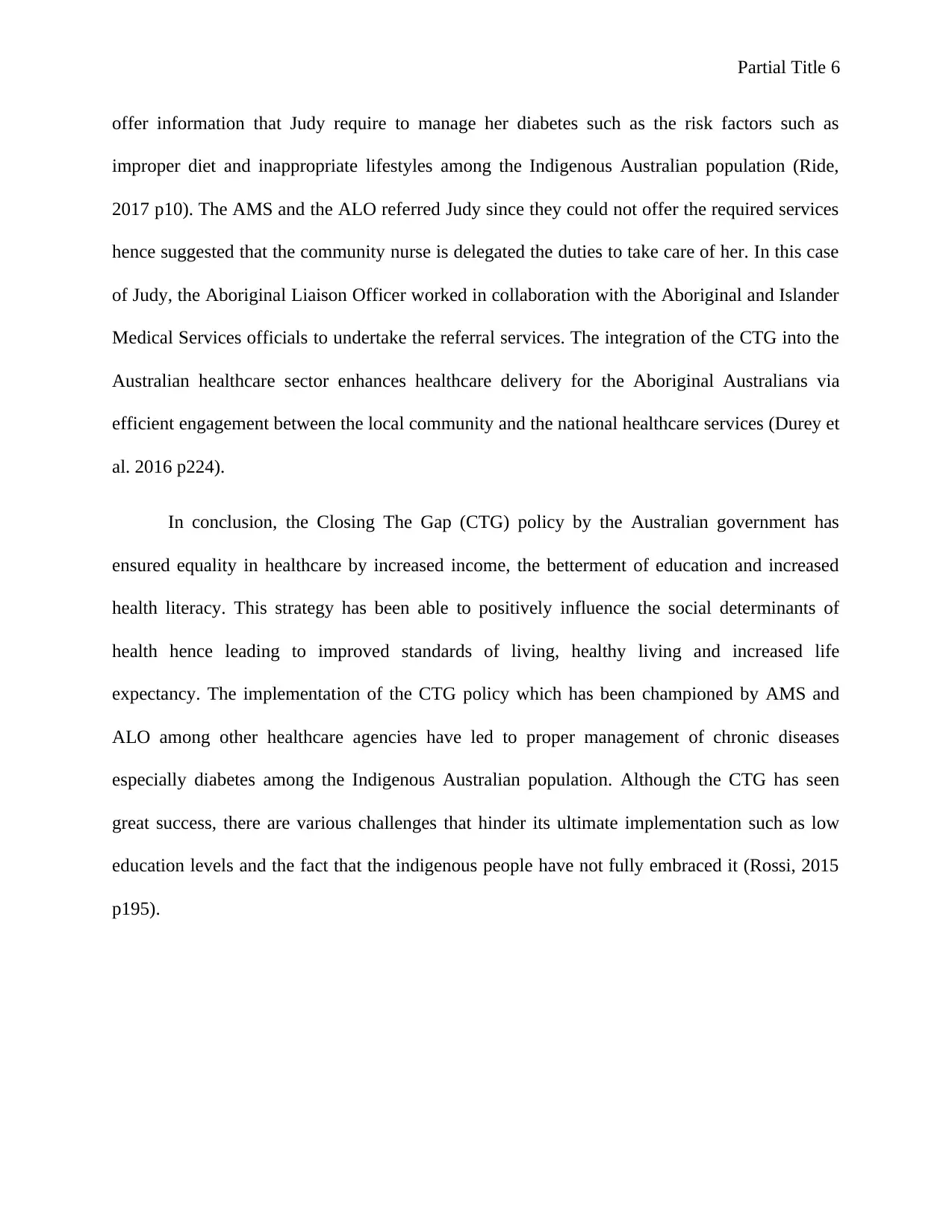
Partial Title 6
offer information that Judy require to manage her diabetes such as the risk factors such as
improper diet and inappropriate lifestyles among the Indigenous Australian population (Ride,
2017 p10). The AMS and the ALO referred Judy since they could not offer the required services
hence suggested that the community nurse is delegated the duties to take care of her. In this case
of Judy, the Aboriginal Liaison Officer worked in collaboration with the Aboriginal and Islander
Medical Services officials to undertake the referral services. The integration of the CTG into the
Australian healthcare sector enhances healthcare delivery for the Aboriginal Australians via
efficient engagement between the local community and the national healthcare services (Durey et
al. 2016 p224).
In conclusion, the Closing The Gap (CTG) policy by the Australian government has
ensured equality in healthcare by increased income, the betterment of education and increased
health literacy. This strategy has been able to positively influence the social determinants of
health hence leading to improved standards of living, healthy living and increased life
expectancy. The implementation of the CTG policy which has been championed by AMS and
ALO among other healthcare agencies have led to proper management of chronic diseases
especially diabetes among the Indigenous Australian population. Although the CTG has seen
great success, there are various challenges that hinder its ultimate implementation such as low
education levels and the fact that the indigenous people have not fully embraced it (Rossi, 2015
p195).
offer information that Judy require to manage her diabetes such as the risk factors such as
improper diet and inappropriate lifestyles among the Indigenous Australian population (Ride,
2017 p10). The AMS and the ALO referred Judy since they could not offer the required services
hence suggested that the community nurse is delegated the duties to take care of her. In this case
of Judy, the Aboriginal Liaison Officer worked in collaboration with the Aboriginal and Islander
Medical Services officials to undertake the referral services. The integration of the CTG into the
Australian healthcare sector enhances healthcare delivery for the Aboriginal Australians via
efficient engagement between the local community and the national healthcare services (Durey et
al. 2016 p224).
In conclusion, the Closing The Gap (CTG) policy by the Australian government has
ensured equality in healthcare by increased income, the betterment of education and increased
health literacy. This strategy has been able to positively influence the social determinants of
health hence leading to improved standards of living, healthy living and increased life
expectancy. The implementation of the CTG policy which has been championed by AMS and
ALO among other healthcare agencies have led to proper management of chronic diseases
especially diabetes among the Indigenous Australian population. Although the CTG has seen
great success, there are various challenges that hinder its ultimate implementation such as low
education levels and the fact that the indigenous people have not fully embraced it (Rossi, 2015
p195).
⊘ This is a preview!⊘
Do you want full access?
Subscribe today to unlock all pages.

Trusted by 1+ million students worldwide
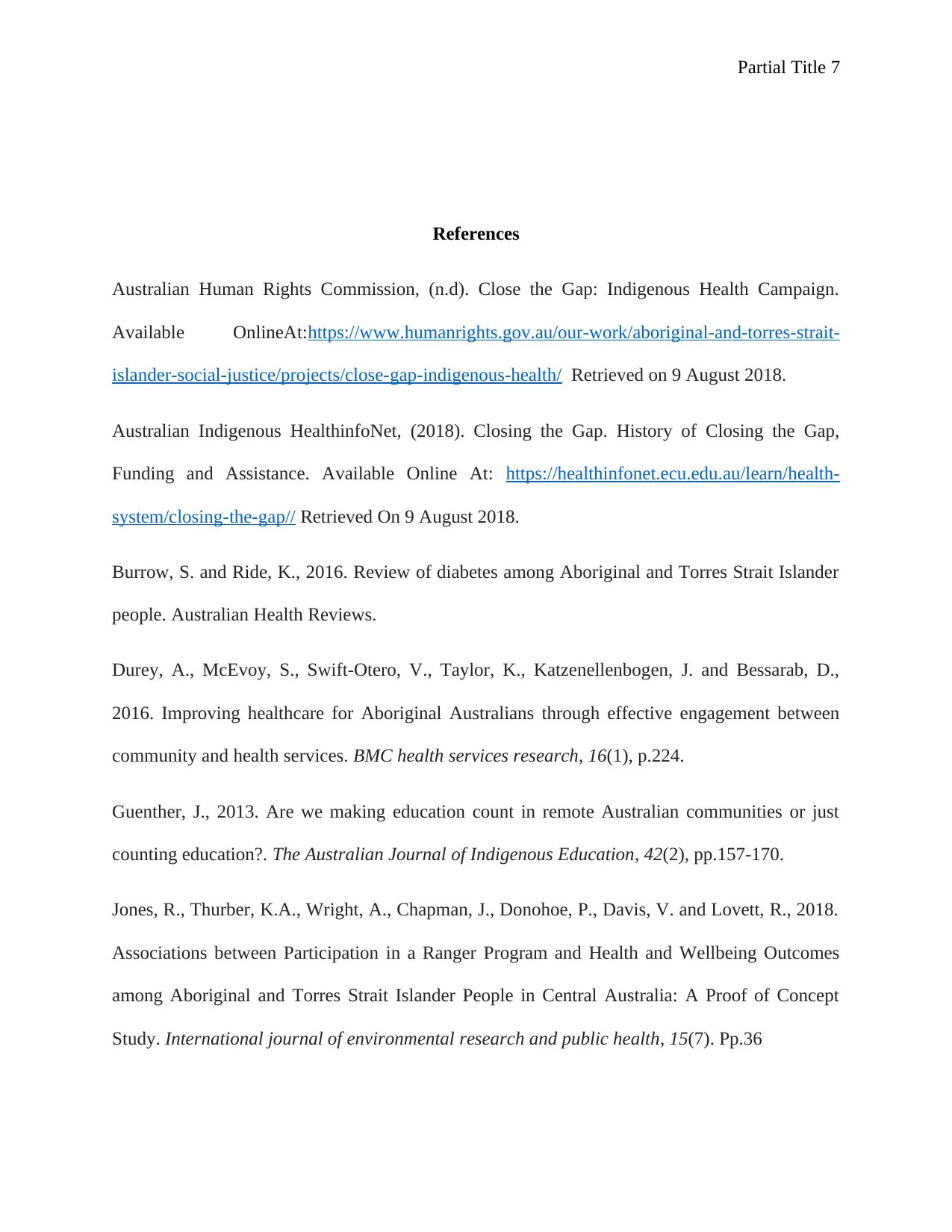
Partial Title 7
References
Australian Human Rights Commission, (n.d). Close the Gap: Indigenous Health Campaign.
Available OnlineAt:https://www.humanrights.gov.au/our-work/aboriginal-and-torres-strait-
islander-social-justice/projects/close-gap-indigenous-health/ Retrieved on 9 August 2018.
Australian Indigenous HealthinfoNet, (2018). Closing the Gap. History of Closing the Gap,
Funding and Assistance. Available Online At: https://healthinfonet.ecu.edu.au/learn/health-
system/closing-the-gap// Retrieved On 9 August 2018.
Burrow, S. and Ride, K., 2016. Review of diabetes among Aboriginal and Torres Strait Islander
people. Australian Health Reviews.
Durey, A., McEvoy, S., Swift-Otero, V., Taylor, K., Katzenellenbogen, J. and Bessarab, D.,
2016. Improving healthcare for Aboriginal Australians through effective engagement between
community and health services. BMC health services research, 16(1), p.224.
Guenther, J., 2013. Are we making education count in remote Australian communities or just
counting education?. The Australian Journal of Indigenous Education, 42(2), pp.157-170.
Jones, R., Thurber, K.A., Wright, A., Chapman, J., Donohoe, P., Davis, V. and Lovett, R., 2018.
Associations between Participation in a Ranger Program and Health and Wellbeing Outcomes
among Aboriginal and Torres Strait Islander People in Central Australia: A Proof of Concept
Study. International journal of environmental research and public health, 15(7). Pp.36
References
Australian Human Rights Commission, (n.d). Close the Gap: Indigenous Health Campaign.
Available OnlineAt:https://www.humanrights.gov.au/our-work/aboriginal-and-torres-strait-
islander-social-justice/projects/close-gap-indigenous-health/ Retrieved on 9 August 2018.
Australian Indigenous HealthinfoNet, (2018). Closing the Gap. History of Closing the Gap,
Funding and Assistance. Available Online At: https://healthinfonet.ecu.edu.au/learn/health-
system/closing-the-gap// Retrieved On 9 August 2018.
Burrow, S. and Ride, K., 2016. Review of diabetes among Aboriginal and Torres Strait Islander
people. Australian Health Reviews.
Durey, A., McEvoy, S., Swift-Otero, V., Taylor, K., Katzenellenbogen, J. and Bessarab, D.,
2016. Improving healthcare for Aboriginal Australians through effective engagement between
community and health services. BMC health services research, 16(1), p.224.
Guenther, J., 2013. Are we making education count in remote Australian communities or just
counting education?. The Australian Journal of Indigenous Education, 42(2), pp.157-170.
Jones, R., Thurber, K.A., Wright, A., Chapman, J., Donohoe, P., Davis, V. and Lovett, R., 2018.
Associations between Participation in a Ranger Program and Health and Wellbeing Outcomes
among Aboriginal and Torres Strait Islander People in Central Australia: A Proof of Concept
Study. International journal of environmental research and public health, 15(7). Pp.36
Paraphrase This Document
Need a fresh take? Get an instant paraphrase of this document with our AI Paraphraser
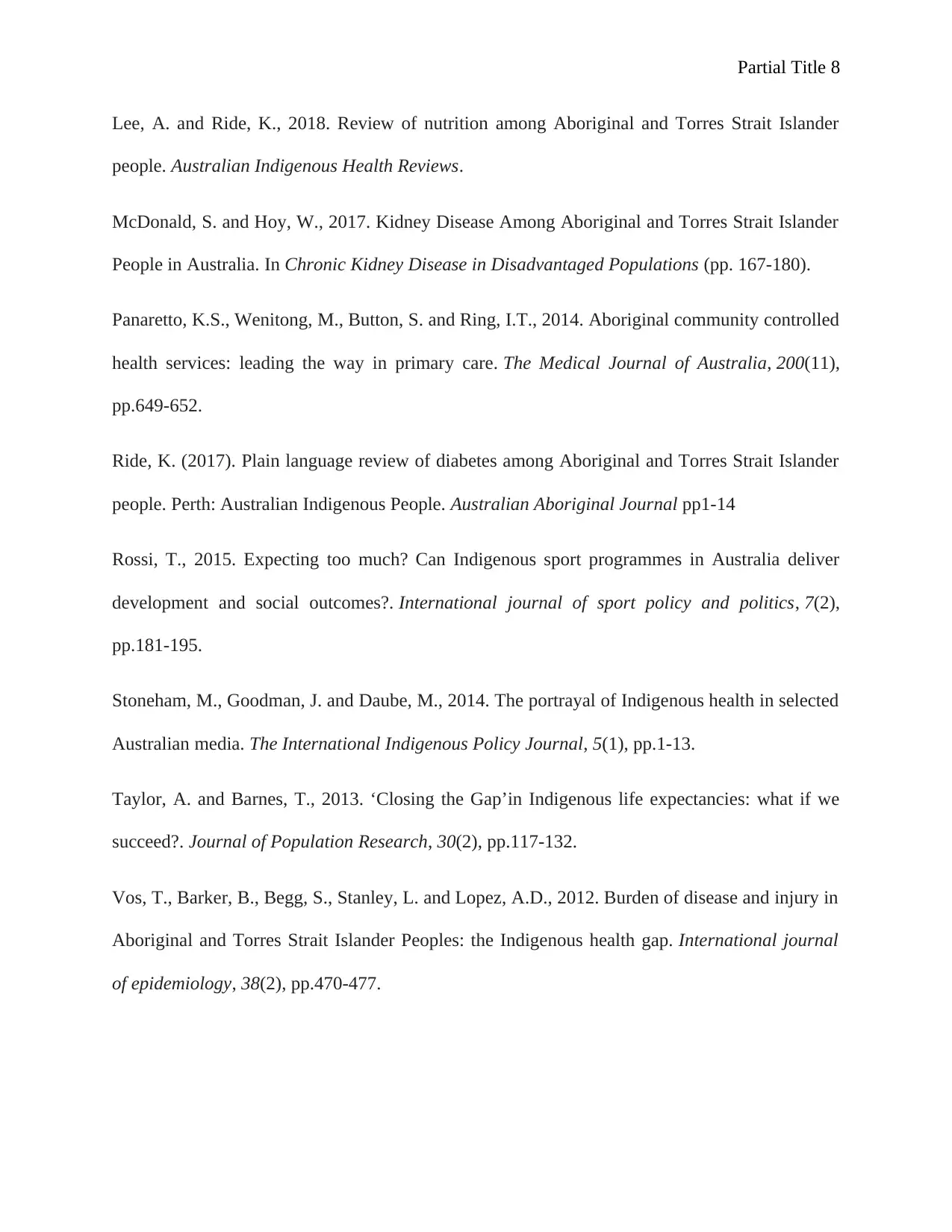
Partial Title 8
Lee, A. and Ride, K., 2018. Review of nutrition among Aboriginal and Torres Strait Islander
people. Australian Indigenous Health Reviews.
McDonald, S. and Hoy, W., 2017. Kidney Disease Among Aboriginal and Torres Strait Islander
People in Australia. In Chronic Kidney Disease in Disadvantaged Populations (pp. 167-180).
Panaretto, K.S., Wenitong, M., Button, S. and Ring, I.T., 2014. Aboriginal community controlled
health services: leading the way in primary care. The Medical Journal of Australia, 200(11),
pp.649-652.
Ride, K. (2017). Plain language review of diabetes among Aboriginal and Torres Strait Islander
people. Perth: Australian Indigenous People. Australian Aboriginal Journal pp1-14
Rossi, T., 2015. Expecting too much? Can Indigenous sport programmes in Australia deliver
development and social outcomes?. International journal of sport policy and politics, 7(2),
pp.181-195.
Stoneham, M., Goodman, J. and Daube, M., 2014. The portrayal of Indigenous health in selected
Australian media. The International Indigenous Policy Journal, 5(1), pp.1-13.
Taylor, A. and Barnes, T., 2013. ‘Closing the Gap’in Indigenous life expectancies: what if we
succeed?. Journal of Population Research, 30(2), pp.117-132.
Vos, T., Barker, B., Begg, S., Stanley, L. and Lopez, A.D., 2012. Burden of disease and injury in
Aboriginal and Torres Strait Islander Peoples: the Indigenous health gap. International journal
of epidemiology, 38(2), pp.470-477.
Lee, A. and Ride, K., 2018. Review of nutrition among Aboriginal and Torres Strait Islander
people. Australian Indigenous Health Reviews.
McDonald, S. and Hoy, W., 2017. Kidney Disease Among Aboriginal and Torres Strait Islander
People in Australia. In Chronic Kidney Disease in Disadvantaged Populations (pp. 167-180).
Panaretto, K.S., Wenitong, M., Button, S. and Ring, I.T., 2014. Aboriginal community controlled
health services: leading the way in primary care. The Medical Journal of Australia, 200(11),
pp.649-652.
Ride, K. (2017). Plain language review of diabetes among Aboriginal and Torres Strait Islander
people. Perth: Australian Indigenous People. Australian Aboriginal Journal pp1-14
Rossi, T., 2015. Expecting too much? Can Indigenous sport programmes in Australia deliver
development and social outcomes?. International journal of sport policy and politics, 7(2),
pp.181-195.
Stoneham, M., Goodman, J. and Daube, M., 2014. The portrayal of Indigenous health in selected
Australian media. The International Indigenous Policy Journal, 5(1), pp.1-13.
Taylor, A. and Barnes, T., 2013. ‘Closing the Gap’in Indigenous life expectancies: what if we
succeed?. Journal of Population Research, 30(2), pp.117-132.
Vos, T., Barker, B., Begg, S., Stanley, L. and Lopez, A.D., 2012. Burden of disease and injury in
Aboriginal and Torres Strait Islander Peoples: the Indigenous health gap. International journal
of epidemiology, 38(2), pp.470-477.
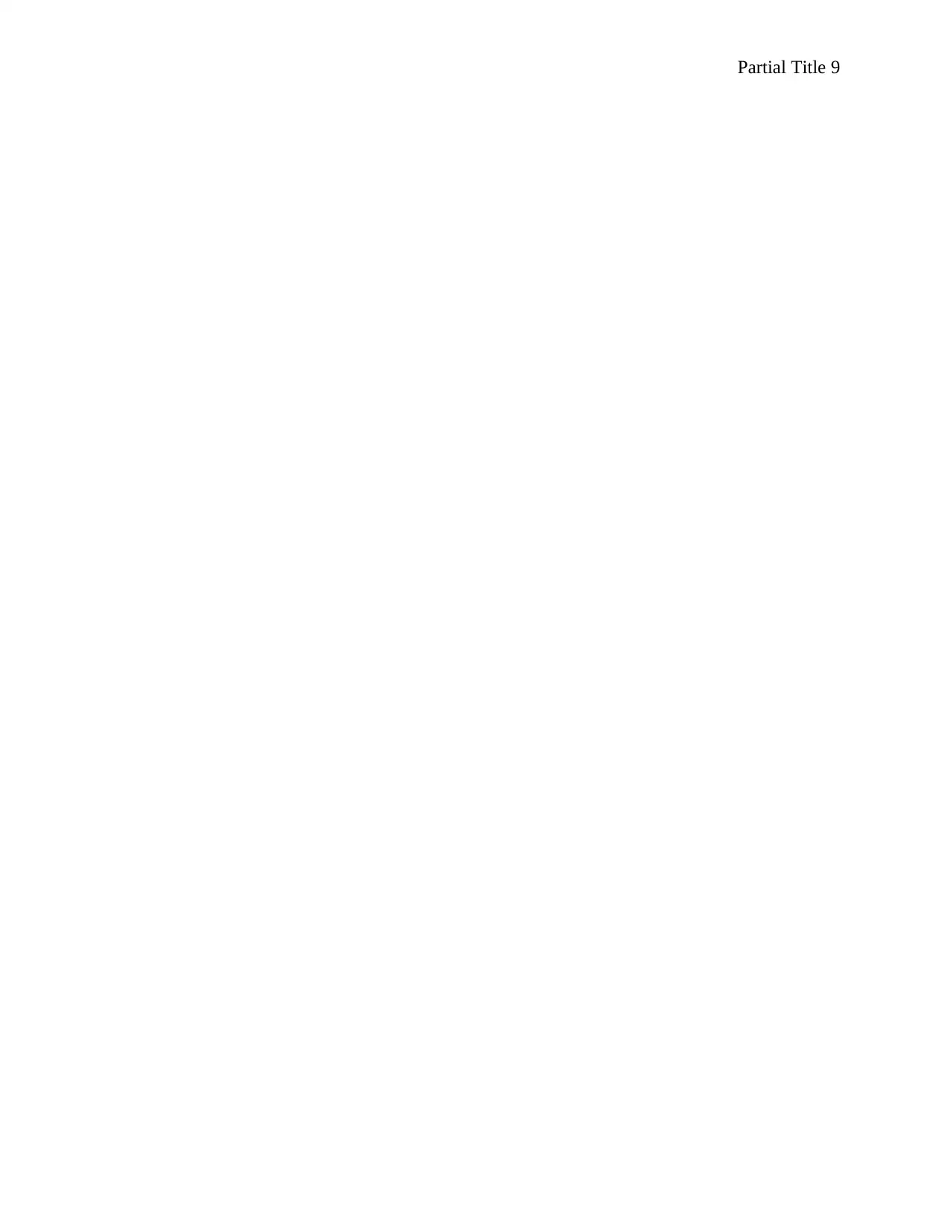
Partial Title 9
⊘ This is a preview!⊘
Do you want full access?
Subscribe today to unlock all pages.

Trusted by 1+ million students worldwide
1 out of 9
Related Documents
Your All-in-One AI-Powered Toolkit for Academic Success.
+13062052269
info@desklib.com
Available 24*7 on WhatsApp / Email
![[object Object]](/_next/static/media/star-bottom.7253800d.svg)
Unlock your academic potential
Copyright © 2020–2025 A2Z Services. All Rights Reserved. Developed and managed by ZUCOL.




